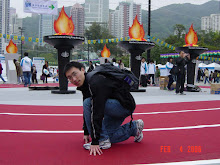d1/r1=d2/r2=d3/r3
Now if you look at it as two equations, then you have the trajectory as two circles, possibly degenerate to lines. Then you take the intersection of the two circles(lines) and check if you have the desired point. This is messy to implement.
A better way is watashi's solution. You look for the scaling factor theta. Code with comments below.
One more solution: you can binary search the scaling factor if you know how to check whether three circles have common area. Notice that pairwise intersection does not imply all three have common area. The paper discussed conditions that three circles overlap, let p1 and p2 be two points of circle C1 intersects C2, then p1 is inside C3 and p2 is outside C3. This ensures the commentator problem has a feasible solution.
http://www.dtic.mil/cgi-bin/GetTRDoc?Location=U2&doc=GetTRDoc.pdf&AD=ADA463920
// For (x1,y1,r1) and (x2,y2,r2), the trajectory is a circle, or a line if
// r1=r2
//
// the official solution is to find the intersection of two circle/line, which
// is quite messy to implement. there are 4 cases, line-line, line-circle,
// circle-line and circle-circle.
//
// Algorithm:
// take a second look at the equations
//
// (x-x0)^2 + (y-y0)^2 = (s*r0)^2
// (x-x1)^2 + (y-y1)^2 = (s*r1)^2
// (x-x2)^2 + (y-y2)^2 = (s*r2)^2
//
// we can find s(theta), and then get x,y
// -2(x0-x2)*x + -2(y0-y2)*y = s^2*(r0^2-r2^2) - (x0^2+y0^2)
// -2(x1-x2)*x + -2(y1-y2)*y = s^2*(r1^2-r2^2) - (x1^2+y1^2)
//
// Comments:
// - we only need theta2, that is s^2
// - s^2 need to be >1
// - there might be two s values, the problem asks for the smaller one
//
#include
#include
using namespace std;
const double EPS=1.0e-7;
int main()
{
double x[3],y[3],r[3];
for(int i=0; i<3; ++i)
scanf("%lf %lf %lf", &x[i],&y[i],&r[i]);
double a[2],b[2],c[2],d[2],det, x1,x2,y1,y2, delta;
a[0]=-2*(x[0]-x[2]); a[1]=-2*(x[1]-x[2]);
b[0]=-2*(y[0]-y[2]); b[1]=-2*(y[1]-y[2]);
c[0]=r[0]*r[0]-r[2]*r[2]; c[1]=r[1]*r[1]-r[2]*r[2];
d[0]=x[2]*x[2]-x[0]*x[0]+y[2]*y[2]-y[0]*y[0];
d[1]=x[2]*x[2]-x[1]*x[1]+y[2]*y[2]-y[1]*y[1];
det=a[0]*b[1]-b[0]*a[1]; // det != 0 because three centers non-collinear
fprintf(stderr,"%lf\n", det);
x1=(b[1]*c[0]-b[0]*c[1])/det; // matrix inv
y1=(c[1]*a[0]-c[0]*a[1])/det;
x2=(b[1]*d[0]-b[0]*d[1])/det;
y2=(a[0]*d[1]-a[1]*d[0])/det;
fprintf(stderr,"%lf %lf %lf %lf\n",x1,y1,x2,y2);
a[0]=x1*x1+y1*y1;
b[0]=2*x1*(x2-x[0])+2*y1*(y2-y[0])-r[0]*r[0];
c[0]=(x2-x[0])*(x2-x[0])+(y2-y[0])*(y2-y[0]);
delta=b[0]*b[0]-4*a[0]*c[0];
fprintf(stderr,"%lf %lf %lf (%lf)\n", a[0],b[0],c[0],delta);
double theta2; // theta^2, theta is the scaling factor, theta>1
if (fabs(a[0])
} else { theta2=-c[0]/b[0]; }
} else {
if (delta<-EPS) theta2=-1;
else {
theta2=(-b[0]-sqrt(fabs(delta)))/(2*a[0]); // prefer smaller theta2
fprintf(stderr,"%lf\n",theta2);
if (theta2<1-EPS) {
theta2=(-b[0]+sqrt(fabs(delta)))/(2*a[0]);
}
}
}
fprintf(stderr,"%lf\n", theta2);
if (theta2>1-EPS) {
double xans=x1*theta2+x2, yans=y1*theta2+y2;
printf("%.6lf %.6lf\n", xans, yans);
}
else {
//printf("No Solution.\n");
}
}

No comments:
Post a Comment